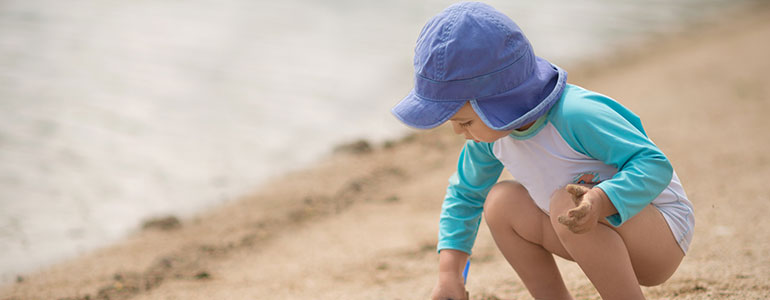UV Protective Children’s Swim Suits Are Now Considered To Be Personal Protective Equipment in Europe

11 Jun 2019
What are the key challenges for manufacturers, distributors and retailers of UV protective clothing?
There is strong evidence that sun exposure and sunburns during childhood increases the risk of one-day developing skin cancer and the recognition of this has driven international regulatory bodies to establish standards and test protocols for UV protective clothing. Since April 2018, UV protective clothing, such as children's sun-safe swimwear, has been considered as Category 1 Personal Protective Equipment (PPE) under the scope of the EU Regulation for Personal Protective Equipment 2016/425.
A focus on design, pattern and colour and how this impacts protection against solar radiation is particularly important. Darker colours tend to absorb more UV than lighter colours, including whites and pastels, but bright colours are also good at absorbing UV radiation. If your swimwear products are patterned, a best practice approach would be to test the different coloured sections of the garments to ensure that all parts of the clothing item offer suitable protection.
Infant and baby swimsuits which protect from head to toe provide maximum coverage. The minimum coverage for a sun-safe child garment is specified in EN 13758-2 which has specifications for coverage for the upper body and lower body. Does your product conform to these specifications?
How does this affect your business?
If your clothing products have previously been marked to carry a sun protection UPF rating they will now need to be certified based on PPE regulation (EU) 2016/425. Conforming to these standards demonstrates to your distributors, retailers and consumers that your organisation is following current regulations and that your brand values improved product safety and quality.
What should you do now?
The steps to ensure conformity can be complex, involving test programs under controlled conditions and robust documentation, however consultation with experienced industry professionals who specialize in UV protection clothing evaluation can help de-risk and accelerate the process to ensuring regulatory conformity with PPE regulation (EU) 2016/425. At Intertek, we can address all of your testing, labelling and documentation challenges and so help you to bring a safe, compliant and well-performing sun-safe garment to market.
Learn more, download our full article now:
Article Download: Meeting Regulatory Requirements for UV Protection Clothing

Dave Smith,
Technical Support Manager,
Global Softlines
Dave Smith is the Technical Support Manager for the Global Softlines team within Intertek. He is an active BSI committee member with a career spanning nearly two decades in textiles and PPE testing, with a specialist focus on children's safety, performance sports and outdoor clothing, working with retailers and suppliers to ensure their products are compliant with current legislation/regulations.